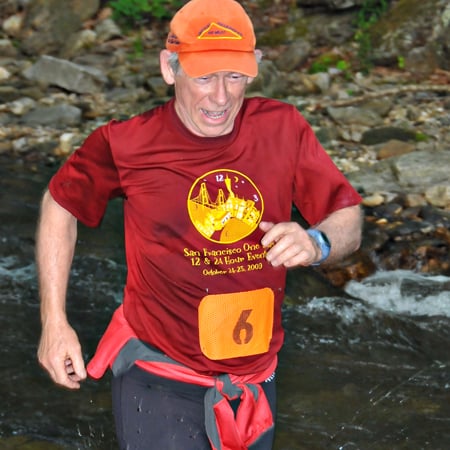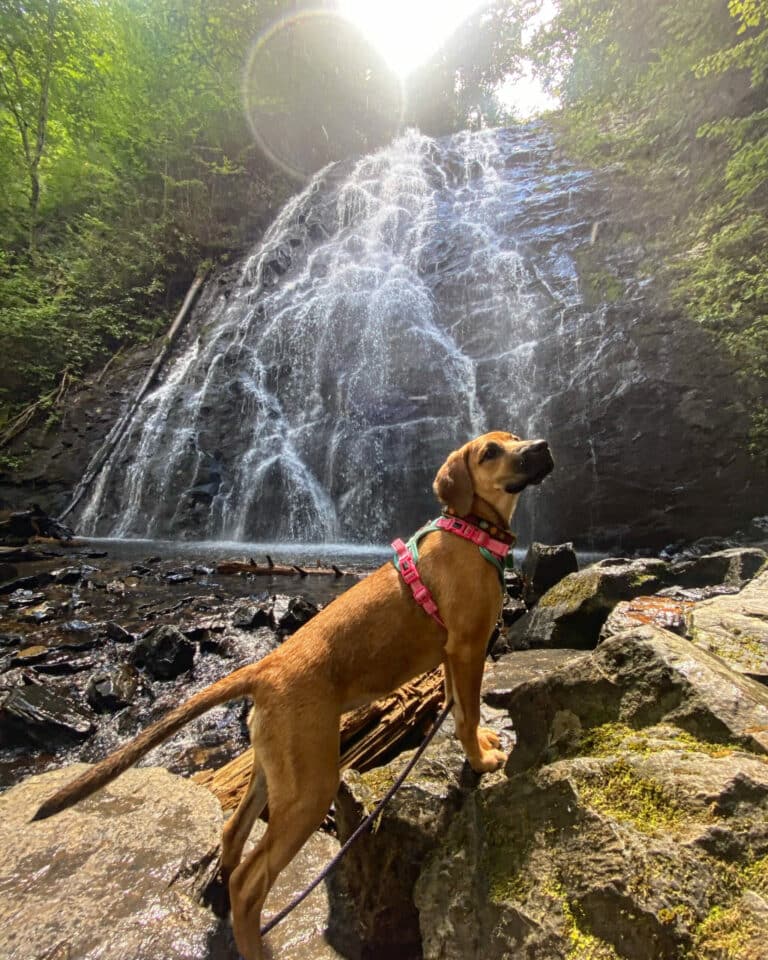This month 11 runners anxiously wait for their phone to ring. The captain of Norm’s Maggots, the relay team that dominates the Southeastern relay running scene, decides who will receive a call to compete in the Smoky Mountain Relay this April. Being chosen means paying race fees, taking leave from work, getting little sleep for days on end, riding in a van with five stinky teammates, and racing a difficult course on which the only thing more brutal than the relentless mountain climbs are the quad-busting descents that follow. But being chosen also means a weekend of returning to those locker room days of no responsibility, when peanut M&Ms and Gatorade constituted a proper meal and exchanges of lewd banter passed as conversation. And then there’s the appeal of being part of a winning team.
The standard reply to an invite for a spot on the team is, “Well, if you don’t get anyone faster, I’ll run.” Maggots want what’s best for the team, but each runner admits to secretly hoping that nobody faster is asked. Getting a spot on the team requires more than just fast race times. The self-proclaimed “oldest and slowest” Maggot gets invited back every year because he offers the team the steady perspective of experience. And two Maggot Chicks rounded out the 2012 team, in part because they’re easy on the nose, not to mention the eyes. To be a Maggot requires equal measures of dedication and humor. But to really find out what the Maggots’ winning spirit is all about, the team recreated the inaugural year of the Smoky Mountain Relay—the race they didn’t win.
The Race
This grassroots race started in 2010 and was modeled after the Hood to Coast Relay in Oregon. The Smoky Mountain Relay requires teams of 12 runners to split into two vans that leapfrog one another to race 212.5 miles. Each runner completes three legs during the race, with every runner completing one leg in the dark.
The Smoky Mountain Relay course is more beautiful, remote, and rugged than its western counterpart. Starting in North Mills River and finishing in Bryson City, N.C., the course treats runners to views from the Blue Ridge Parkway and the Mountain-to-Sea Trail. The Hood to Coast consists of paved roads, while the Smoky Mountain Relay takes place mostly on trails and forest service roads. The Smoky Mountain Relay also hosts fewer teams than Hood to Coast, which means runners might run all three legs without seeing another runner.
A few years ago, Jim Brendle got a hare-brained idea to start the relay. A pharmaceutical rep living in Oregon, he missed the Smoky Mountains, his childhood stomping grounds. The one hiccup—Jim had never planned a race. From obtaining permits to getting port-a-potties and signage posted, each task required more time and cost more money than he anticipated. And he completely underestimated how difficult plotting a course from across the country would be. He’s learned the hard way.
The Start
The year is 2010, the first year of the Smoky Mountain Relay. The attitude of the Maggots is one of prepared confidence. They are the undefeated winners of the other relay held in the Southeast, the Blue Ridge Mountain Relay. This new relay takes place right in their backyard, on the trails they frequently run.
The Maggots start at 2 p.m. at the Mills River campground. The relay is staggered so that no team will be running the most difficult-to-navigate trail legs in the dark. The team with the slowest predicted finish time takes the earliest start slot, which is 5 a.m. The Maggots arrive at the starting spot well before their mid-afternoon start time. Two high-school-aged girls who start the team off fill them in about a last minute course change—the second exchange point where relay runner two will hand off to relay runner three has been moved slightly farther down the course.
With a press of the watch timer, the first runner starts. The Maggots slated to run the first six legs load into the van and rush to the second exchange point to give Dave Perkins, the second runner, enough time to warm up. Dave sees the first runner approach the exchange point and per their custom, they greet one another with “Maggot” to confirm the runner is indeed one of their own. The first runner smoothly passes the wristband to Dave, who begins his four mile leg.
Getting Lost
Unlike the other Maggots, Dave never ran on a cross county team. Dave didn’t even start running until he was 37 years old. He was slow at first. Running helped him shed 90 pounds. Then he joined the Maggots’ Tuesday night track workouts and began running 70 miles a week. Gradually his running times improved and he predicts he will average a 6:30 pace on this leg.
The crunch of gravel as his feet fly over the forest service road toward the next exchange point creates a melody with the whitewater flowing in Mills River, some 70 feet down a steep ravine to his left. To his right, the mountain pitch climbs at such a steep grade that it’s surprising to see dense vegetation growing. Leaning forward into the exhilarating downhill that continues for over a mile, he unleashes his speed.
Now with the steep uphill in front of him, Dave knows better than to look up. His gaze is fixed fifteen feet in front of him. This is one of the many ego-crushing ascents on the course. Dave knows the visual will only add to his fatigue. Finally cresting the mountain, Dave sees the pull out where the exchange was originally planned to take place. He runs a mile past it, where he sees a parking lot with a small camping area next to the river.
Cars parked and tents pitched, the scene is one of many folks enjoying this sunny April afternoon. He scans the area for any sign of the team van or the Maggot runner who’s slated to run the next leg. Seeing neither, Dave recalls the girls’ directions. They instructed him to look for a gate, and continue down the singletrack.
Dave will replay that scene and his decision to go around the metal gate and down the path for the rest of the relay, in fact for years to come. He will ponder where he took a wrong turn. It will take another visit to the site later to discover that parked cars blocked a small sign indicating that runners turn right some thirty feet before the gate, onto a footpath that looks like it ends abruptly at the campsites. Dave had no way of knowing that the trail continued on the other side of the campsites, following the river in the opposite direction of the trail he took.
Finding the Third Relay Runner
But Dave won’t even start to wonder if he’s taken a wrong turn for a while. For now, he thinks that the race director just messed up an exchange point. The technical trail demands his full attention to negotiate the roots and puddles along the river’s edge. He’s run several miles more than he expected at his predicted 6:30 pace. When he sees a small waterfall adjacent to the trail, Dave leans down and gulps down water. Somewhat refreshed, he digs deeper to keep on pace. Then Dave spots Frankie Adkins, the Maggot team member running the third leg. In Maggot tradition, he yells “Maggot” and hears the familiar reply.
The two run together for a few minutes, smoothly transitioning the wristband. Frankie tells Dave that he saw a blur of a bear running down the mountainside. Perhaps it was the bear sighting that distracted Frankie and caused him to also make a wrong turn. Right now he remains oblivious to the fact that he isn’t on the relay course. Frankie, one of the youngest and fastest on the team, sprints ahead. Dave tries to keep a quick pace, knowing the van will be waiting and in a hurry to beat Frankie to the next exchange point.
When the trail ends, Dave doesn’t see the van. Instead, Dave runs upon Frankie who is studying a map with two hikers. At this point, the exhaustion from Dave’s now 14-mile run is etched on his face and his body slopes with fatigue. The truth sinks in for the first time—they are lost. The map confirms that they’ve been running miles in the opposite direction of the course. By this time it’s nearly 5 p.m. Both men worry that they might be caught out in the wilderness after dark. Their imaginations run wild about having to spend the night wearing only their flimsy running singlets and shorts, without the benefit of water, food, light, or shelter.
Grit and Gumption
Their fears fuel their run with urgency toward the next exchange point, the Pink Beds in Pisgah Forest near Brevard, N.C. The Pink Beds are bogs rarely found in mountain terrain, so-named for the profusion of pink blooms in the springtime. Frankie runs ahead and Dave soon loses sight of him altogether. Dave begins to regret starting out his unintended twenty-some mile leg so fast. As the steep terrain flattens out, he realizes he’s reached the swampy plateau that is the Pink Beds. The beavers have been hard at work this past spring building new dams that have resulted in chest-deep difficult-to-cross creeks. Muddy and wet, Dave becomes turned around in this swampland.
Meanwhile, the rest of the team debates where the lost Maggots might be. The team thinks their race is over. If they quit now, they could spend the night in the comfort of their own beds. Now three hours behind the team’s predicted time, it looks like the Maggots have lost any shot at victory.
Just as one team member dials Search and Rescue, Frankie approaches the van. Runner four, Matt Roane, leaps into action. With the wristband in his grasp, Matt takes off like he’s got a shot at making up the lost time. The team follows Matt’s quiet leadership, putting any thought of the debacle behind them and focusing on running consistently fast splits.
With Dave still lost, team member Jay Curwen, the guy who knows what to do with a map and compass from his adventure racing days, convinces the team to let him go search for Dave. Luckily Jay knows exactly where to look and he quickly finds Dave. Back in the van, the team rushes to make it to the next exchange point where Matt will hand off to runner five.
The Comeback
The team lost precious daylight hours by getting lost, and they face navigating trails that pose the greatest challenges to staying on course by headlamp. The runners also must deal with a certain paranoia that builds when running in the woods at night. Any red eyes reflecting the light of a runner’s headlamp could belong to a boar, mountain lion, or bear. They aren’t alone on the course. The runners will have to battle these mental challenges in addition to sleep deprivation.
With wristband in hand, running legend Norm Blair, the team’s namesake, takes off into the dark on his short three-mile leg. The owner of Jus’ Running store and a sponsor of the relay, Norm didn’t expect to be part of the team. Retired from a successful racing career for many years, he answered the call to join the team when a last-minute substitute was needed for an injured runner. Race director Jim Brendle says that finding out that Norm was running was, “like having Elvis show up for the race.”
For this running legend, who has logged ten miles a day for decades and expects to complete a lifetime total of 140,000 miles by the end of 2013, a 3-mile run is a piece of cake. But the rest of the team worries. The run takes place on a deer track strewn with ankle-twisting rocks almost impossible to see in the dark. The steep grade adds to the difficulty of this short leg, which culminates with fording the now swollen-from-a-recent-rain creek. The creek’s strong current poses a real danger for runners without swift water skills, and race officials have assured teams that a rope will be in place to help runners safely cross the whitewater.
But when Norm searches for a rope at the creek’s edge, he comes up empty handed. Without missing a stride, he sets his gaze on the far side of the creek, barely discernable by the beam of his headlamp. Undeterred by the menacing sound of the rushing water now almost thigh-high, he pumps his arms to compensate for the effort of slogging his legs through the shockingly cold water, propelling his body across the creek. With the creek behind him, Norm runs the half mile between him and the van where his dry sweats await.
The next runner faces an even more daunting leg. This is one of the few legs longer than seven miles. The race officials wouldn’t even consider allowing a runner on another team to set out on this trail in the dark. But they make an exception for the Maggots, especially for Jay, known for his navigational prowess and familiarity with this portion of the Mountains-to-Sea trail. Even for Jay, distinguishing the pink tape meant to mark the course from tape left by surveryors over the years proves challenging. Jay finds himself doubling back time and again, to examine a piece of tape and decipher the route. A testament to his knack for finding his way out of tough spots, he finishes at his predicted time.
With a pass of the wristband, Jay sends the next runner onto the course. The team reasons that if other teams are suffering similar time delays, maybe they’re not as far behind as feared. In the first early morning hours when the night has passed but dawn has yet to arrive, the Maggots pass a runner on another team for the first time. The Maggots are back in the race.
The Finish
Each runner builds on the lead gained by the previous runner, passing at least one team during his leg. They’ve been passing teams all morning as they close in on the lead, one runner at a time. Hearing reports that only fifteen minutes separate them from the lead team, the Maggots send their anchor out for the final leg leading to the finish in Bryson City.
But 200-plus mile relays can be won or lost by mere minutes, and the fifteen-minute gap proves insurmountable even for the Maggots. The Maggots finish second, behind the 6-person Run In team from Greenville, S.C. Team Run In finished in 27 hours, 47 minutes, and 15 seconds. At the finish line, the Maggots can barely stand from sleep deprivation. But after taking showers and eating, the Maggots begin to joke about the trials they encountered, dubbing Dave and Frankie the “Pink Buds.”
The Maggots returned to win the Smoky Mountain Relay in 2011 and 2012. And as this goes to print, team captain Matt Roane is hard at work on race logistics for 2013. Meanwhile, the other Maggots are diligently following their training programs and anticipating the call. •







